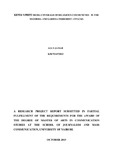| dc.description.abstract | In the recent years, Kenyans have been scarred repeatedly by a series of attacks by the Al Shabaab terrorist group based in neighbouring Somalia. The devastating attacks have been characterised by profiling and targeting of non-Muslims, a tactic that has polarised Kenyans along religious lines and increased likelihood of conflict. This study sought to find out how the print media covered religious communities, specifically Christians and Muslims, in the Al Shabaab attacks in Mandera (November/December 2014) and Garissa University College (April 2015) in the context of the Code of Conduct for the Practice of journalism by the Media Council of Kenya (2013) and the backdrop of interreligious polarisation occasioned by previous attacks. Both attacks under study were characterised by separation of Muslims and Christians before the latter were killed. The study analysed contents of 133 news articles that made direct references to the two religious communities within four weeks of the attacks. For the Mandera attack, articles were selected between November 23rd to December 23rd 2014 while for the Garissa attack; they were selected between April 2nd to May 2nd 2015. The study also interviewed six journalists and two editors regarding the print media coverage of those attacks to gain deeper insights into the matter. The study established that the coverage of religious communities in the two publications was largely done professionally in line with the Code of Conduct for the practice of journalism in Kenya with the exceptions of a few shortcomings. In addition, the coverage was largely done in a manner that is not polarising. Instead, the majority of articles published emphasised national unity among Kenyans of all religious communities to combat Al Shabaab. The study recommends that the media should exercise extra caution in reporting terrorist attacks to ensure that they do so professionally and accurately without fanning interreligious polarisation and conflicts in the country. | en_US |

